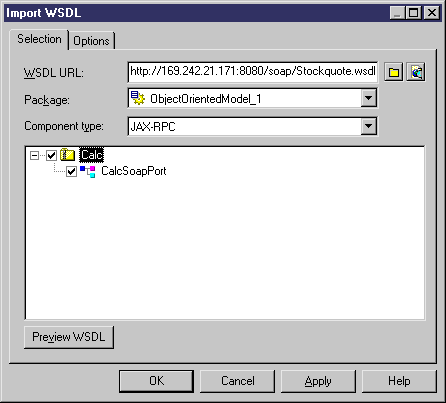PowerDesigner can import WSDL files for .NET and Java.
- Select Language > Import WSDL to open the Import WSDL dialog.
- On the Selection tab, complete the following fields:
Item
Description
WSDL URL
Indicates the location of the WSDL file. You can complete this field by:- Entering the location directly in the field
- Clicking the Browse File tool to browse on your local file system
- Clicking the Browse UDDI tool to search on a UDDI server (see Browsing WSDL Files from UDDI)
Package
Specifies the package and namespace where the component and the Web service class will be created.
Component type
[Java only] Specifies the type of the component to create.
- Select the Web services and port types you want to import.
- [optional] Click the Preview WSDL button to preview the WSDL and the unique key used to locate the UDDI.
- [optional] Click the Options tab, which allows you to specify in which diagrams PowerDesigner should create the symbols for the imported objects. Deselecting an option will suppress the creation of a symbol, but the object will still be imported.
- Click OK to begin the import.
A progress box is displayed. If the model in which you are reverse engineering already contains data, the Merge Models dialog opens to allow you to select how the imported objects will be merged with your model
For detailed information about merging models, see Core Features Guide > Modeling with PowerDesigner > Comparing and Merging Models.
Each Web service selected will be imported as a component and an implementation class. Each port type selected in a selected Web service generates an interface.
Note: If the WSDL contains a section prefixed with <!-- service -->, a component instance is created. This section is displayed in the WSDL tab in the property sheet of the component instance.
